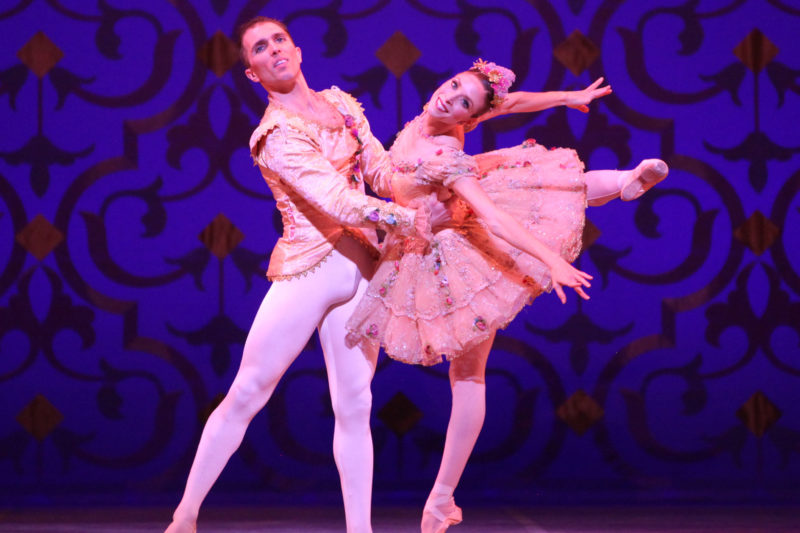No Longer Stepping Around Age, Dancer Faces Looming Curtain Call
By Riley Neuheardt
Reporting Texas

Paul Bloodgood performs with Ashley Lynn Sherman in “The Nutcracker.” Photo courtesy Anne Marie Bloodgood
Paul Bloodgood’s career began at 8 years old, when he put down his video game long enough to learn a combination in one of the dance classes his mom took as exercise.
She was impressed that he paid attention, and soon enrolled him in dance classes twice a week. The after-school activity quickly became serious, and his childhood dream of being a baseball player lost its luster. By 13, Bloodgood was dancing five to six days a week at Seattle’s prestigious Pacific Northwest Ballet School. Then it was time to audition for a professional company.
“I never actually realized that it’s something you could do for a living,” Bloodgood said.
But Bloodgood did make it his living. The 36-year-old is entering his 15th season with Ballet Austin and his 18th professional season overall. He’s danced and auditioned for companies around the country, traveled to China and Israel to perform original pieces and even met his wife, Anne Marie, during rehearsals. He trains full time to keep his muscles engaged and body conditioned, just as traditional athletes do. Bloodgood is as close to a veteran presence as Ballet Austin has.
“He’s become a stalwart in our organization and he’s someone I go to constantly in terms of roles I need filled,” said Stephen Mills, artistic director for Ballet Austin. “I trust him.”
But with each passing season, Bloodgood said he feels the physical toll of ballet more and more.
Ballet can be rigorous, and Bloodgood trains 40 hours a week. Each member of Ballet Austin’s 20-member company works in every piece during the year, whether it be a classical ballet such as “Swan Lake” or an original contemporary piece that Mills creates. There isn’t always time to heal before preparation for the next piece begins.
“There’s this joke that for every week you take off from dancing, it takes you double that to get back to where you were,” Bloodgood said. “I’d say it’s more like triple at my age now.”
Bloodgood has battled serious injuries. At 31, micro-tears in his left Achilles tendon required him to wear a therapeutic boot for six to eight weeks. He attributes the injury to constant strain from years of not lowering his heels all the way in jumps. The injury still requires physical therapy and conditioning. Bloodgood avoided surgery, and the risk of retirement that came with it, and let the tears heal naturally.
He tore his left oblique muscle when he was 34. The injury caused a lumbar strain so severe that it forced a 3-millimeter bulge in his spine. He took off months from dance, but didn’t want the injury to force him to retire. He didn’t feel fully healthy until almost a year and a half later.
Bloodgood said people in his life still don’t realize how athletic ballet is.
A few years ago, Bloodgood took an interest and began training in martial arts. He invited 25 to 30 of his martial arts friends to see him perform Ballet Austin’s version of “Hamlet,” a masculine piece filled with fencing, death and dark music.
His friends were shocked at the athleticism of ballet. Instead of a 360-degree turning jump, like they’d do in martial arts, they were watching Bloodgood effortlessly do “double tours,” which are 720-degree turning jumps.
“They had never seen ballet in their life before, and I was trying to explain to them how so many of the movements in martial arts are the exact same as in dance,” Bloodgood said. “It’s just a question of whether you flex your foot at the end of something.”
For Bloodgood, inviting friends to watch rehearsals or come backstage at performances helps to mend the conventional idea that men performing ballet is feminine or easy. He said being able to hear how hard the dancers are breathing and hitting the floor during performances changes people’s perspective.
“We’re supposed to make it look like we’re not exerting any energy,” Bloodgood said. “It’s something that should be known to people now. They need to know how hard it is.”
He recognizes that his retirement from professional ballet is imminent, so he is already thinking about his next stage of life. He and Anne Marie run a film and photography business called Bloodygood Pictures. This year, Bloodgood will premiere his first feature-length documentary, “Trenches of Rock,” which chronicles the 30-year history of his father’s Christian rock band, Bloodgood. He said his next steps will be toward working in production full time.
Anne Marie Bloodgood, who retired from Ballet Austin after 14 seasons to raise the couple’s 18-month-old son Michael, said her husband is constantly taking on his next project and setting new goals.
“He’s had such a great dance career, but the thing that’s really why he’s so successful is because he never stops working,” she said. “That’s a challenge, to remind him to even take a break.”
But Bloodgood knows that a break is coming, and said he’s excited to fully transition from performance to production.
“I’m definitely not done with dance,” Bloodgood said. “I definitely still love what I do. But I’m not 25 anymore and it’s inevitable at this point.”